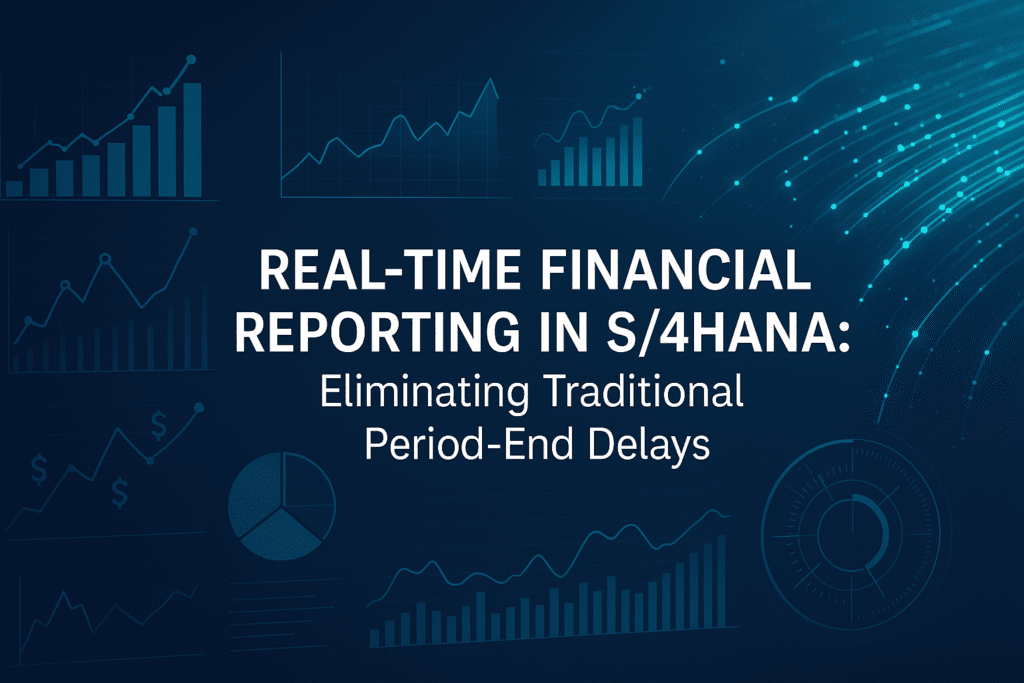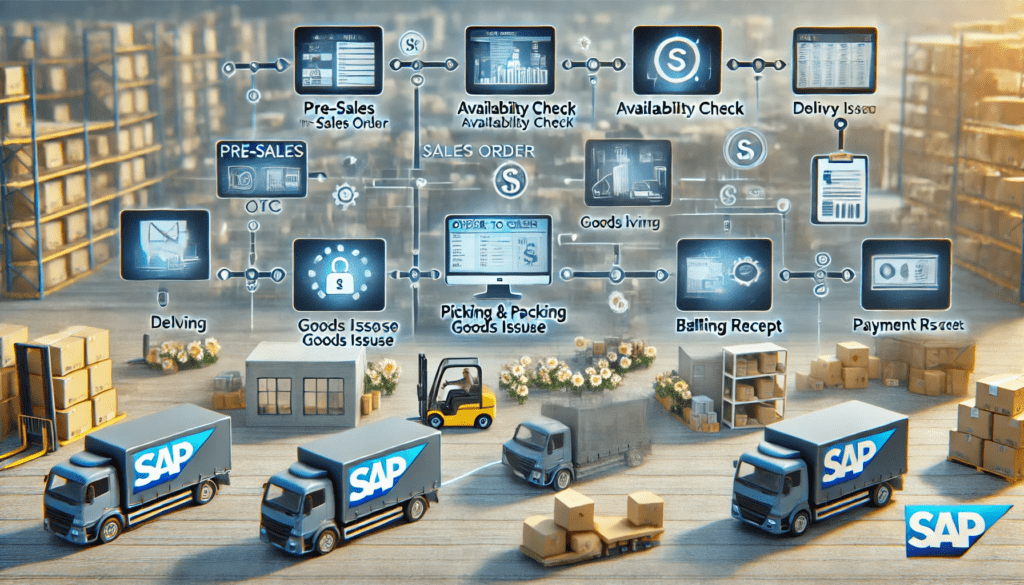Real-time financial reporting in SAP S/4HANA represents a paradigmatic shift from periodic, batch-driven financial processes to continuous, immediate insight generation. By leveraging SAP HANA’s in-memory computing capabilities and the revolutionary Universal Journal architecture, organizations can eliminate the traditional week-long period-end closing cycles that have plagued finance teams for decades. With 70% of CFOs viewing real-time financial data as crucial for effective decision-making, S/4HANA’s continuous reporting capabilities transform finance from a retrospective function into a proactive strategic partner.
The Traditional Period-End Challenge
Legacy Reporting Limitations
Traditional financial reporting in SAP ECC and other legacy systems relies heavily on batch processing and overnight job runs, creating significant delays in financial visibility. Finance teams typically spend 7-8 hours on processes that can now be completed in less than an hour, with month-end closing cycles extending 2-3 weeks due to reconciliation requirements between Financial Accounting (FI) and Controlling (CO) modules.
Core Legacy System Problems:
Batch-based data processing requiring overnight runs for report generation
Fragmented data storage across multiple tables creating reconciliation nightmares
Limited scalability constraining real-time analysis capabilities
Reactive decision-making based on outdated financial information
Manual intervention requirements for period-end procedures
Impact on Business Operations
The delay inherent in traditional financial reporting creates cascading business challenges. Organizations report 50% of help desk tickets related to financial closing issues, while finance teams experience significant stress during period-end cycles. More critically, outdated financial information prevents agile response to market changes and strategic opportunities.
S/4HANA’s Real-Time Architecture Revolution
In-Memory Computing Foundation
SAP S/4HANA’s in-memory computing architecture fundamentally transforms financial data processing by storing information in RAM rather than traditional disk-based systems. This architectural change enables sub-second query response times for complex financial analyses and eliminates the need for pre-calculated aggregate tables.
Technical Advantages:
Columnar data processing enabling rapid analytical queries
On-the-fly calculations replacing batch-generated totals
Parallel processing capabilities across multiple dimensions
Real-time data compression reducing storage requirements by 80-90%
Unified OLTP and OLAP processing eliminating data replication
Universal Journal Integration
The Universal Journal (ACDOCA) serves as the cornerstone of real-time financial reporting by consolidating all financial and controlling data into a single table structure. This revolutionary approach eliminates the traditional separation between legal and management accounting, providing instantaneous access to integrated financial information.
Universal Journal Benefits:
Permanently reconciled financials with zero FI-CO reconciliation effort
Real-time profitability analysis across all business dimensions
Instant drill-down capabilities from summary to transaction detail
Unified data source serving as the single source of truth
Enhanced audit trails with complete transaction lineage
Continuous Closing and Soft Close Concepts
From Hard Close to Continuous Accounting
S/4HANA enables organizations to transition from traditional “hard close” procedures to “continuous closing” methodologies. This transformation allows finance teams to perform closing activities throughout the period rather than concentrating all efforts at month-end.
Continuous Closing Advantages:
Soft close capability enabling daily/weekly financial position assessment
Event-driven processing replacing scheduled batch runs
Real-time variance analysis with immediate corrective actions
Distributed workload eliminating period-end pressure peaks
Proactive issue resolution before period-end deadlines
Financial Closing Cockpit Automation
The SAP Financial Closing Cockpit provides comprehensive orchestration of closing processes with automated task management and real-time monitoring. Organizations using this functionality report 50% faster closing cycles and enhanced compliance governance.
Closing Cockpit Features:
Centralized task management with dependency-driven workflows
Automated closing cycle execution with event-based triggers
Real-time progress monitoring across multiple entities
Preconfigured templates based on industry best practices
Enhanced collaboration tools with notification and escalation automation
Real-Time Reporting Capabilities
Instantaneous Financial Visibility
S/4HANA’s real-time reporting enables immediate access to current financial positions without waiting for overnight processing cycles. Finance teams can generate live profit and loss statements, real-time balance sheets, and dynamic cash flow analyses with drill-down capabilities to transaction-level detail.
Real-Time Reporting Features:
Interactive dashboards with role-based KPI monitoring
Mobile accessibility enabling anywhere, anytime financial analysis
Predictive analytics integration with machine learning algorithms
Multi-dimensional analysis across cost centers, profit centers, and market segments
Regulatory compliance monitoring with automated exception alerts
Enhanced Decision-Making Support
Organizations implementing S/4HANA real-time reporting experience 60% faster decision-making cycles and 40% improvement in forecast accuracy. The immediate availability of financial data enables CFOs to respond instantly to board inquiries with comprehensive analysis and scenario modeling.
Decision Support Enhancements:
What-if scenario modeling with instant results
Trend analysis with predictive forecasting capabilities
Cross-company consolidation in real-time
Automated anomaly detection for proactive management
Integrated planning capabilities aligning strategy with operations
Quantified Business Benefits and ROI
Operational Efficiency Improvements
Organizations implementing S/4HANA real-time reporting achieve measurable operational improvements across multiple dimensions. IDC research demonstrates that companies experience a 25% improvement in finance team operations with productivity increases of 26% for finance staff.
Measured Performance Gains:
Financial processes reduced from 7-8 hours to less than 1 hour
50% reduction in help desk tickets related to financial operations
18% improvement in both error reduction and budgetary cycle time
40% reduction in data processing time enabling faster decision-making
20% increase in operational efficiency through automated processes
Revenue and Cost Impact
Real-time financial reporting delivers significant bottom-line impact through enhanced business agility and operational efficiency. Organizations report 3.1% increase in revenue from improved business operations, translating to $42.1 million additional annual revenue for participating companies.
Financial Impact Metrics:
547% five-year ROI with 10.6-month payback period
$433,200 per 100 employees in quantified benefits over five years
30% reduction in total finance function costs through automation
15% reduction in inventory carrying costs through improved forecasting
20% improvement in delivery performance via real-time analytics
Advanced Analytics and Predictive Capabilities
Machine Learning Integration
S/4HANA’s real-time architecture provides the foundation for advanced AI and machine learning applications directly integrated into financial processes. Organizations can implement predictive analytics, automated anomaly detection, and intelligent process automation without complex data extraction procedures.
AI-Enabled Capabilities:
Predictive cash flow modeling using historical transaction patterns
Automated variance investigation with intelligent root cause analysis
Dynamic customer credit scoring based on real-time payment behaviors
Intelligent journal entry validation preventing errors before posting
Automated regulatory compliance monitoring with proactive alerts
Advanced Financial Close Automation
SAP Advanced Financial Closing (AFC) leverages real-time data to enable predictive accounting and continuous close optimization. Organizations can start closing processes earlier in the period with real-time and predictive month-end data.
Predictive Closing Features:
Automated predictive journal entries in dedicated extension ledgers
Real-time consolidation capabilities across multiple entities
Continuous accounting processes distributing workload throughout the month
Intelligent situation handling for proactive issue resolution
Cross-system closing orchestration with centralized monitoring
Implementation Considerations and Challenges
Technical Migration Requirements
Transitioning to real-time financial reporting requires comprehensive system architecture transformation and process reengineering. Organizations must address data migration complexity, custom code adaptation, and user training requirements to fully realize real-time benefits.
Implementation Challenges:
Data model transformation from multiple tables to Universal Journal structure
Custom report modifications to leverage real-time capabilities
Interface adaptations for third-party system connections
User training requirements for new analytical paradigms
Change management processes for transformed finance roles
Organizational Change Management
Real-time financial reporting fundamentally changes how finance professionals work, requiring comprehensive organizational adaptation. Finance teams must evolve from periodic transaction processors to continuous strategic advisors.
Change Requirements:
Role redefinition reflecting real-time analytical capabilities
Process standardization leveraging embedded automation
Skill development for advanced analytics and scenario modeling
Governance framework updates for enhanced data quality and controls
Performance measurement alignment with real-time insights
Future-Ready Financial Operations
Cloud-Native Deployment Benefits
S/4HANA’s real-time reporting architecture aligns perfectly with cloud-native deployment models, enabling organizations to leverage elastic computing resources and advanced analytics services. The simplified data structure reduces cloud infrastructure requirements while enhancing scalability for global operations.
Cloud Optimization Advantages:
Reduced cloud storage costs through simplified data models
Enhanced scalability with elastic computing capabilities
Integrated analytics services without separate data warehousing
Automated backup and recovery with streamlined structures
Global deployment flexibility with standardized data models
Competitive Advantage Through Real-Time Insights
Organizations implementing real-time financial reporting establish sustainable competitive advantages through superior financial agility and insight generation. The ability to provide immediate, accurate financial analysis positions companies as industry leaders in financial excellence and strategic responsiveness.
Strategic Advantages:
Proactive risk management with continuous monitoring
Agile strategic planning based on real-time performance data
Enhanced stakeholder confidence through transparent reporting
Accelerated innovation cycles with faster financial validation
Market responsiveness enabling rapid competitive adjustments
The Future of Financial Reporting
Real-time financial reporting in SAP S/4HANA represents more than technological advancement—it embodies a fundamental transformation of finance from a retrospective reporting function to a proactive strategic enabler. By eliminating traditional period-end delays, organizations unlock unprecedented financial transparency, operational efficiency, and strategic agility that defines the future of enterprise finance.
The convergence of in-memory computing, artificial intelligence, and cloud-native architectures creates transformative possibilities for financial operations. Organizations embracing real-time financial reporting position themselves not only for operational excellence but for sustained competitive advantage in an increasingly dynamic business environment.
Through S/4HANA’s real-time capabilities, the traditional concept of “closing the books” evolves into “continuous financial intelligence”—enabling organizations to operate with financial clarity and strategic insight that was previously impossible.



